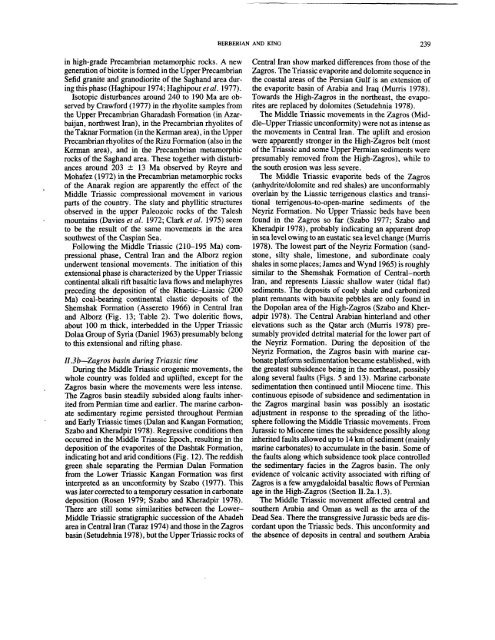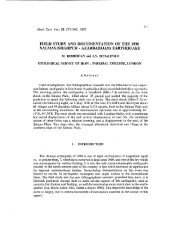PDF COPY - Manuel berberian
PDF COPY - Manuel berberian
PDF COPY - Manuel berberian
Create successful ePaper yourself
Turn your PDF publications into a flip-book with our unique Google optimized e-Paper software.
in high-grade Precambrian metamorphic rocks. A new<br />
generation of biotite is formed in the Upper Precambrian<br />
Sefid granite and granodiorite of the Saghand area during<br />
this phase (Haghipour 1974; Haghipour et al. 1977).<br />
Isotopic disturbances around 240 to 190 Ma are observed<br />
by Crawford (1977) in the rhyolite samples from<br />
the Upper Precambrian Gharadash Formation (in Azarbaijan,<br />
northwest Iran), in the Precambrian rhyolites of<br />
the Taknar Formation (in the Kerman area), in the Upper<br />
Precambrian rhyolites of the Rizu Formation (also in the<br />
Kerman area), and in the Precambrian metamorphic<br />
rocks of the Saghand area. These together with disturbances<br />
around 203 + 13 Ma observed by Reyre and<br />
Mohafez (1972) in the Precambrian metamorphic rocks<br />
of the Anarak region are apparently the effect of the<br />
Middle Triassic compressional movement in various<br />
parts of the country. The slaty and phyllitic structures<br />
observed in the upper Paleozoic rocks of the Talesh<br />
mountains (Davies et al. 1972; Clark et al. 1975) seem<br />
to be the result of the same movements in the area<br />
southwest of the Caspian Sea.<br />
Following the Middle Triassic (210-195 Ma) compressional<br />
phase, Central Iran and the Alborz region<br />
underwent tensional movements. The initiation of this<br />
extensional phase is characterized by the Upper Triassic<br />
continental alkali rift basaltic lava flows and melaphyres<br />
preceding the deposition of the Rhaetic-Liassic (200<br />
Ma) coal-bearing continental clastic deposits of the<br />
Shemshak Formation (Assereto 1966) in Central Iran<br />
and Alborz (Fig. 13; Table 2). Two doleritic flows,<br />
about 100 m thick, interbedded in the Upper Triassic<br />
Dolaa Group of Syria (Daniel 1963) presumably belong<br />
to this extensional and rifting phase.<br />
H.3b---Zagros basin during Triassic time<br />
During the Middle Triassic orogenic movements, the<br />
whole country was folded and uplifted, except for the<br />
Zagros basin where the movements were less intense.<br />
The Zagros basin steadily subsided along faults inherited<br />
from Permian time and earlier. The marine carbonate<br />
sedimentary regime persisted throughout Permian<br />
and Early Triassic times (Dalan and Kangan Formation;<br />
Szabo and Kheradpir 1978). Regressive conditions then<br />
occurred in the Middle Triassic Epoch, resulting in the<br />
deposition of the evaporites of the Dashtak Formation,<br />
indicating hot and arid conditions (Fig. 12). The reddish<br />
green shale separating the Permian Dalan Formation<br />
from the Lower Triassic Kangan Formation was first<br />
interpreted as an unconformity by Szabo (1977). This<br />
was later corrected to a temporary cessation in carbonate<br />
deposition (Rosen 1979; Szabo and Kheradpir 1978).<br />
There are still some similarities between the Lower-<br />
Middle Triassic stratigraphic succession of the Abadeh<br />
area in Central Iran (Taraz 1974) and those in the Zagros<br />
basin (Setudehnia 1978), but the Upper Triassic rocks<br />
BERBERIAN AND KING 239<br />
Central Iran show marked differences from those of the<br />
Zagros. The Triassic evaporite and dolomite sequence in<br />
the coastal areas of the Persian Gulf is an extension of<br />
the evaporite basin of Arabia and Iraq (Murris 1978).<br />
Towards the High-Zagros in the northeast, the evaporites<br />
are replaced by dolomites (Setudehnia 1978).<br />
The Middle Triassic movements in the Zagros (Middie-Upper<br />
Triassic unconformity) were not as intense as<br />
the movements in Central Iran. The uplift and erosion<br />
were apparently stronger in the High-Zagros belt (most<br />
of the Triassic and some Upper Permian sediments were<br />
presumably removed from the High-Zagros), while to<br />
the south erosion was less severe.<br />
The Middle Triassic evaporite beds of the Zagros<br />
(anhydrite/dolomite and red shales) are unconformably<br />
overlain by the Liassic terrigenous clastics and transitional<br />
terrigenous-to-open-madne sediments of the<br />
Neyriz Formation. No Upper Triassic beds have been<br />
found in the Zagros so far (Szabo 1977; Szabo and<br />
Kheradpir 1978), probably indicating an apparent drop<br />
in sea level owing to an eustatic sea level change (Murris<br />
1978). The lowest part of the Neyriz Formation (sandstone,<br />
silty shale, limestone, and subordinate coaly<br />
shales in some places; James and Wynd 1965) is roughly<br />
similar to the Shemshak Formation of Central-north<br />
Iran, and represents Liassic shallow water (tidal flat)<br />
sediments. The deposits of coaly shale and carbonized<br />
plant remnants with bauxite pebbles are only found in<br />
the Dopolan area of the High-Zagros (Szabo and Kheradpir<br />
1978). The Central Arabian hinterland and other<br />
elevations such as the Qatar arch (Murris 1978) presumably<br />
provided detrital material for the lower part of<br />
the Neyriz Formation. During the deposition of the<br />
Neyriz Formation, the Zagros basin with marine carbonate<br />
platform sedimentation became established, with<br />
the greatest subsidence being in the northeast, possibly<br />
along several faults (Figs. 5 and 13). Marine carbonate<br />
sedimentation then continued until Miocene time. This<br />
continuous episode of subsidence and sedimentation in<br />
the Zagros marginal basin was possibly an isostatic<br />
adjustment in response to the spreading of the lithosphere<br />
following the Middle Triassic movements. From<br />
Jurassic to Miocene times the subsidence possibly along<br />
inherited faults allowed up to 14 km of sediment (mainly<br />
marine carbonates) to accumulate in the basin. Some of<br />
the faults along which subsidence took place controlled<br />
the sedimentary facies in the Zagros basin. The only<br />
evidence of volcanic activity associated with rifting of<br />
Zagros is a few amygdaloidal basaltic flows of Permian<br />
age in the High-Zagros (Section II.2a. 1.3).<br />
The Middle Triassic movement affected central and<br />
southern Arabia and Oman as well as the area of the<br />
Dead Sea. There the transgressive Jurassic beds are discordant<br />
upon the Triassic beds. This unconformity and<br />
the absence of deposits in central and southern Arabia







